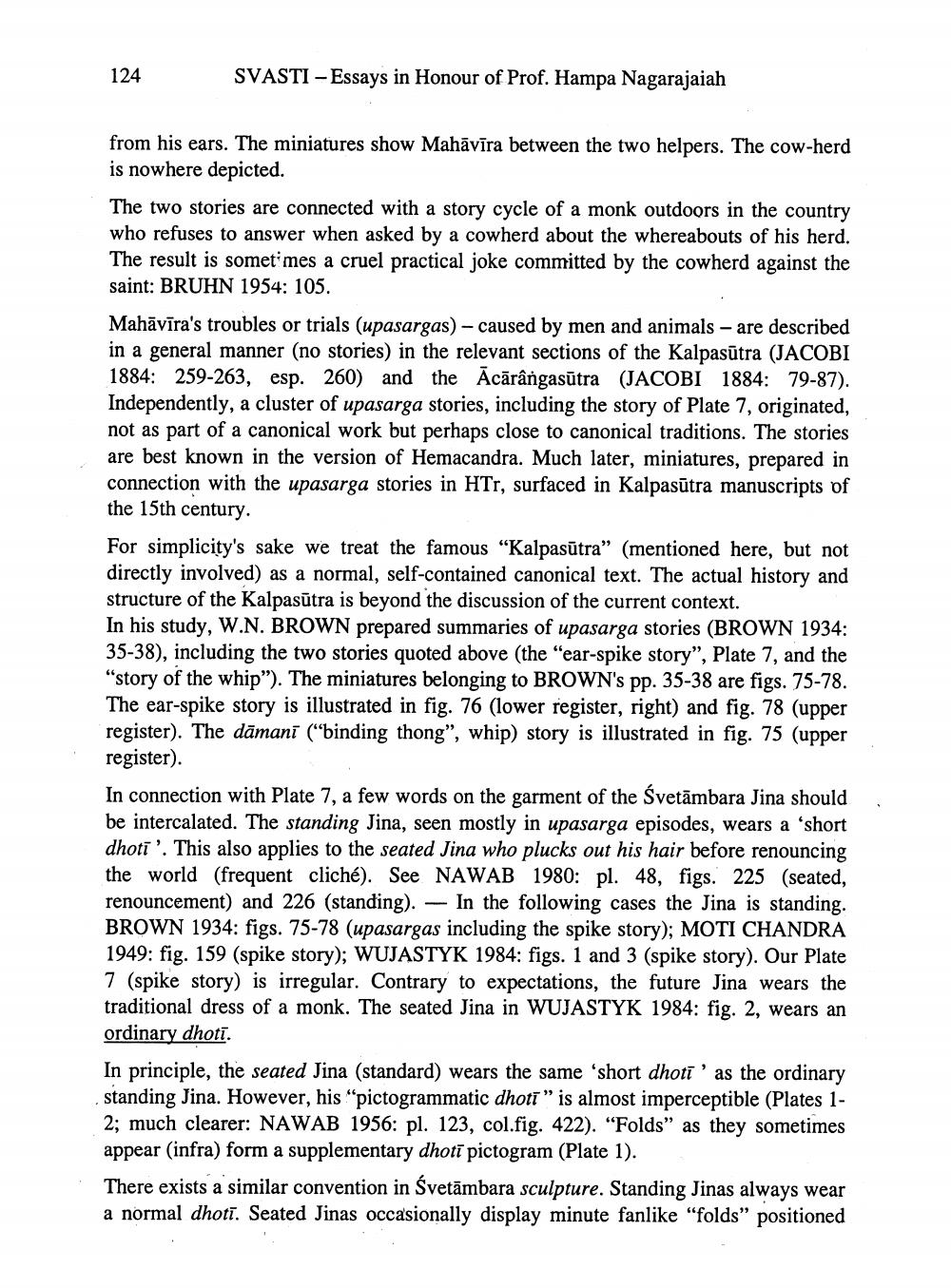________________
124
SVASTI-Essays in Honour of Prof. Hampa Nagarajaiah
from his ears. The miniatures show Mahāvīra between the two helpers. The cow-herd is nowhere depicted.
The two stories are connected with a story cycle of a monk outdoors in the country who refuses to answer when asked by a cowherd about the whereabouts of his herd. The result is sometimes a cruel practical joke committed by the cowherd against the saint: BRUHN 1954: 105.
Mahavira's troubles or trials (upasargas) - caused by men and animals are described in a general manner (no stories) in the relevant sections of the Kalpasūtra (JACOBI 1884: 259-263, esp. 260) and the Acãrângasütra (JACOBI 1884: 79-87). Independently, a cluster of upasarga stories, including the story of Plate 7, originated, not as part of a canonical work but perhaps close to canonical traditions. The stories are best known in the version of Hemacandra. Much later, miniatures, prepared in connection with the upasarga stories in HTr, surfaced in Kalpasūtra manuscripts of the 15th century.
For simplicity's sake we treat the famous "Kalpasūtra" (mentioned here, but not directly involved) as a normal, self-contained canonical text. The actual history and structure of the Kalpasūtra is beyond the discussion of the current context.
In his study, W.N. BROWN prepared summaries of upasarga stories (BROWN 1934: 35-38), including the two stories quoted above (the "ear-spike story", Plate 7, and the "story of the whip"). The miniatures belonging to BROWN's pp. 35-38 are figs. 75-78. The ear-spike story is illustrated in fig. 76 (lower register, right) and fig. 78 (upper register). The damant ("binding thong", whip) story is illustrated in fig. 75 (upper register).
In connection with Plate 7, a few words on the garment of the Śvetämbara Jina should. be intercalated. The standing Jina, seen mostly in upasarga episodes, wears a 'short dhoti'. This also applies to the seated Jina who plucks out his hair before renouncing the world (frequent cliché). See NAWAB 1980: pl. 48, figs. 225 (seated, renouncement) and 226 (standing). In the following cases the Jina is standing. BROWN 1934: figs. 75-78 (upasargas including the spike story); MOTI CHANDRA 1949: fig. 159 (spike story); WUJASTYK 1984: figs. 1 and 3 (spike story). Our Plate 7 (spike story) is irregular. Contrary to expectations, the future Jina wears the traditional dress of a monk. The seated Jina in WUJASTYK 1984: fig. 2, wears an ordinary dhoti.
In principle, the seated Jina (standard) wears the same 'short dhoti' as the ordinary standing Jina. However, his "pictogrammatic dhoti" is almost imperceptible (Plates 12; much clearer: NAWAB 1956: pl. 123, col.fig. 422). "Folds" as they sometimes appear (infra) form a supplementary dhoti pictogram (Plate 1).
There exists a similar convention in Svetämbara sculpture. Standing Jinas always wear a normal dhoti. Seated Jinas occasionally display minute fanlike "folds" positioned




